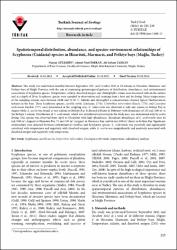| dc.contributor.author | Gülşahin, Nurçin | |
| dc.contributor.author | Tarkan, Ahmet Nuri | |
| dc.contributor.author | Tarkan, Ali Serhan | |
| dc.date.accessioned | 2020-11-20T17:51:20Z | |
| dc.date.available | 2020-11-20T17:51:20Z | |
| dc.date.issued | 2016 | |
| dc.identifier.issn | 1300-0179 | |
| dc.identifier.issn | 1303-6114 | |
| dc.identifier.uri | https://app.trdizin.gov.tr//makale/TWpFek9UVXpNdz09 | |
| dc.identifier.uri | https://hdl.handle.net/20.500.12809/8728 | |
| dc.identifier.uri | https://doi.org/10.3906/zoo-1406-13 | |
| dc.description.abstract | This study was undertaken monthly between September 2011 and October 2012 at 10 stations in Hisarö nü , Marmaris, and Fethiye bays of Muğla Province with the aim of examining spatiotemporal patterns of distribution, abundances, and environmental associations of Scyphozoa species. Temperature, salinity, dissolved oxygen, and chlorophyll-a values were measured both on the surface and at a depth of 20 m. Scyphozoa species were sampled by observation and counting from a boat and by diving. Mean temperatures of the sampling stations were between 20.08 and 21.26 ° C. Salinity and chlorophyll-a concentrations showed typical Mediterranean features in the bays. Three Scyphozoa species, Aurelia aurita (Linnaeus, 1758), Cotylorhiza tuberculata (Macri, 1778), and Cassiopea andromeda Forskå l, 1775, were determined in the sampling sites. C. tuberculata was observed at only one station in Fethiye Bay in August while A. aurita was found at two stations in Fethiye Bay. It showed a bloom in February with abundance of 152 ind./100 m3 at the Fethiye 3 station. Distribution of C. andromeda,which was distributed extensively in the study area, was determined only by scuba diving. This species was observed from April to December with high abundances. Maximum abundances of C. andromeda were 64 ind./100 m2 (August) in Hisarö nü Bay, 71 ind./100 m2 (August) in Marmaris Bay, and 64 ind./100 m2 (June) in Fethiye Bay. Significant relationships were detected between environmental variables and Scyphozoa species. C. andromeda was positively and significantly correlated with temperature and negatively with dissolved oxygen, while A. aurita was insignificantly and positively associated with dissolved oxygen and negatively with temperature. | en_US |
| dc.item-language.iso | eng | en_US |
| dc.item-rights | info:eu-repo/semantics/openAccess | en_US |
| dc.subject | Biyoloji | en_US |
| dc.title | Spatiotemporal distribution, abundance, and species–environment relationships of Scyphozoa (Cnidaria) species in Hisarönü, Marmaris, and Fethiye bays (Muğla, Turkey) | en_US |
| dc.item-type | article | en_US |
| dc.contributor.department | MÜ, Su Ürünleri Fakültesi, Su Ürünleri Temel Bilimleri Bölümü | en_US |
| dc.contributor.institutionauthor | Tarkan, Ali Serhan | |
| dc.identifier.volume | 40 | en_US |
| dc.identifier.issue | 2 | en_US |
| dc.identifier.startpage | 223 | en_US |
| dc.identifier.endpage | 230 | en_US |
| dc.relation.journal | Turkish Journal of Zoology | en_US |
| dc.relation.publicationcategory | Makale - Ulusal Hakemli Dergi - Kurum Öğretim Eleman | en_US |


















